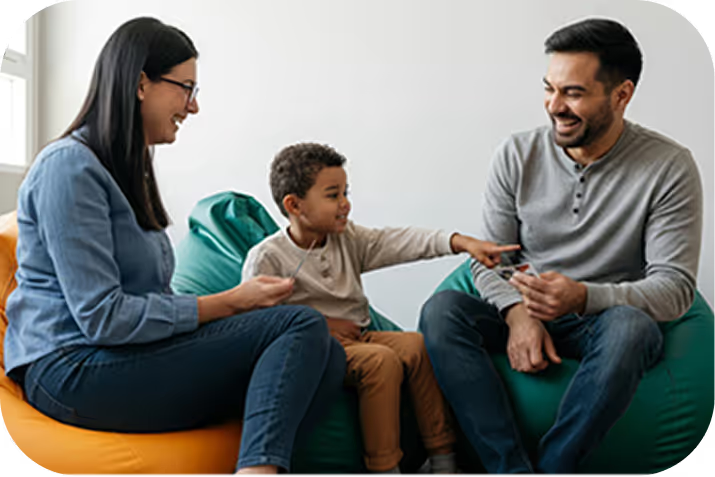Introduction
You've been working with therapists, and you can see the progress your child is making during sessions. But what happens when therapy ends and you head home? Those moments—during dinner, bath time, or weekend family activities—can feel like missed opportunities. What if you could extend that same supportive, structured approach into your everyday routines? The beautiful truth is that your home can become one of the most powerful therapeutic environments for your child.
When you learn to weave Applied Behavior Analysis (ABA) strategies into the rhythms of daily life—from morning routines to bedtime stories—something magical happens. Your child doesn't just practice skills in a clinical setting; they master them in the place where they feel safest and most loved. As a parent, you become not just a caregiver, but a true partner in your child's growth journey, creating countless natural learning opportunities that build on each other day after day.
Key takeaways
Implementing ABA therapy at home empowers families with practical tools that create lasting change:
- At-home ABA therapy benefits include improved communication, reduced behavioral challenges, and stronger parent-child connections.
- Daily ABA therapy routines build structure and consistency that accelerate progress.
- Parents can successfully implement ABA therapy strategies at home with the right training and support.
What is at-home ABA therapy, and why does it matter?
At-home ABA therapy is more than a treatment—it's a family-centered approach that brings autism intervention into natural, everyday environments. According to the CDC, early intervention can significantly improve long-term outcomes for children with autism spectrum disorder.
In this approach, parents take an active role in leading ABA strategies tailored to their child's specific needs, using positive reinforcement to motivate progress and incorporating skill-building exercises aligned with developmental goals.
Creating a supportive environment
Transforming your home into a therapeutic space requires intentional planning. This means establishing consistent daily ABA therapy routines that bring structure and predictability, creating visual schedules to support smoother transitions throughout the day, and designing calm, low-distraction learning areas that help your child stay focused and engaged.
Practical strategies for implementing ABA at home
Effective ABA therapy strategies for parents focus on blending structure with flexibility across three key areas:
1. Structured learning techniques
- Break complex tasks into smaller, manageable steps.
- Use visual aids and clear, concise instructions.
- Implement consistent reward systems to reinforce progress.
2. Communication enhancement
- Practice active listening during daily routines.
- Encourage alternative communication methods (pictures, gestures, devices).
- Validate and respond to non-verbal cues with empathy.
3. Behavior management
- Identify trigger points that lead to challenging behaviors.
- Develop proactive intervention strategies before escalation.
- Maintain calm, consistent responses to reinforce positive behavior.
Pro insight: Successful parent-led ABA therapy doesn't mean recreating a clinic in your living room. Instead, weave strategies into everyday life—meal prep, playtime, and bedtime routines. This natural approach strengthens skills in real-world contexts and keeps therapy engaging.
Your family's path to ABA success
At-home ABA therapy offers parents the opportunity to become active therapeutic partners, turning ordinary moments into powerful opportunities for growth. By implementing daily ABA therapy routines, embracing flexible strategies, and focusing on family-centered autism interventions, families can create lasting change that extends far beyond formal therapy sessions.
Ready to begin your journey?
Book a free consultation with our ABA specialists and discover personalized, parent-led strategies that fit your child's unique needs and your family's lifestyle.
Frequently Asked Questions
ABA therapy at home benefits include stronger family involvement, more natural skill practice, and consistent reinforcement in familiar settings.
Begin with small, consistent steps. Work alongside your child's ABA therapist to learn how to practice ABA therapy at home, focusing first on routines like bedtime or mealtime.
Maintaining consistency, balancing roles, and adapting strategies to a child's needs are common. However, family-centered autism interventions help parents stay supported while ensuring effective therapy.
Sources
Sources
- Centers for Disease Control and Prevention (CDC): Treatment and Interventions for Autism Spectrum Disorder
- Autism Speaks: Applied Behavior Analysis (ABA)
- National Institute of Mental Health (NIMH): Autism Spectrum Disorder
- American Psychological Association (APA): Evidence-Based Practice in ABA
- National Library of Medicine (NIH Study on ABA Effectiveness)
Latest insights
Discover valuable resources for your ABA therapy journey.
Latest insights
Discover valuable resources for your ABA therapy journey.
Join our community
Follow our blog for the latest insights and tips on ABA therapy, autism, and parenting.









